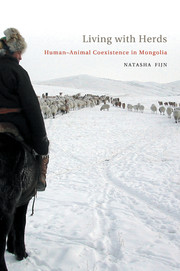Book contents
- Frontmatter
- Contents
- Lists of Plates, Figures, Maps, Tables, and Online Video Segments
- Glossary
- Acknowledgments
- LIVING WITH HERDS
- PART ONE CROSSING BOUNDARIES
- PART TWO THE SOCIAL HERD
- PART THREE LIVING WITH HERDS
- 7 IN THE LAND OF THE HORSE
- 8 THE CYCLE OF LIFE: BIRTH TO DEATH, SPRING TO WINTER
- 9 THE DOMESTIC AND THE WILD
- 10 THE SACRED ANIMAL
- CONCLUSION: CO-DOMESTIC LIVES
- Appendix
- References
- Index
- Plate section
8 - THE CYCLE OF LIFE: BIRTH TO DEATH, SPRING TO WINTER
from PART THREE - LIVING WITH HERDS
Published online by Cambridge University Press: 03 May 2011
- Frontmatter
- Contents
- Lists of Plates, Figures, Maps, Tables, and Online Video Segments
- Glossary
- Acknowledgments
- LIVING WITH HERDS
- PART ONE CROSSING BOUNDARIES
- PART TWO THE SOCIAL HERD
- PART THREE LIVING WITH HERDS
- 7 IN THE LAND OF THE HORSE
- 8 THE CYCLE OF LIFE: BIRTH TO DEATH, SPRING TO WINTER
- 9 THE DOMESTIC AND THE WILD
- 10 THE SACRED ANIMAL
- CONCLUSION: CO-DOMESTIC LIVES
- Appendix
- References
- Index
- Plate section
Summary
INTRODUCTION
In this chapter I describe significant events and activities during the herding year, starting with the birth of the newborn animals in early spring, until the slaughtering of animals in autumn before the onset of winter. In describing spring through to the start of winter, I depict not a full calendar year but at least the main period of herder–herd animal interaction in Mongolia. During the core winter months from mid-November until mid-February, herding families and herd animals resume a period of semi-hibernation in which activity is kept at a minimum to conserve energy so that they might survive the extreme winter conditions. For the rest of the year, daily activity is largely dictated by the routine of the herd animals and by the changing environmental conditions through the change of seasons. In this chapter I provide etho-ethnographic examples of how the herd animals influence particular herders in their day-to-day lives.
Herders are very aware of the changing seasons, weather conditions, and variations in temperature, as their livelihood depends upon it. Each season is very distinct, with dramatic temperature changes and differing weather conditions marking each new season. The average temperature (the midpoint between the daily high and low) in Mongolia is below freezing for seven months of the year (Goldstein & Beall 1994). In winter, the landscape is white with only patches of bare soil on the windswept mountainsides. Every day is short; the sky is blue but the sun barely warms the land.
- Type
- Chapter
- Information
- Living with HerdsHuman-Animal Coexistence in Mongolia, pp. 175 - 200Publisher: Cambridge University PressPrint publication year: 2011



